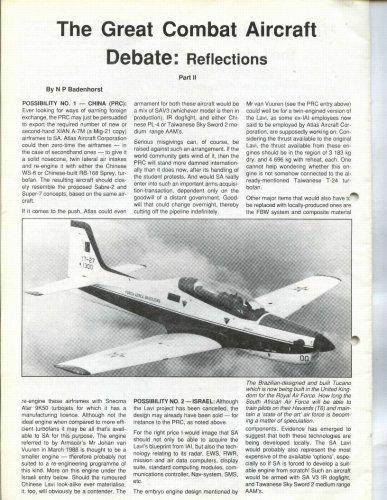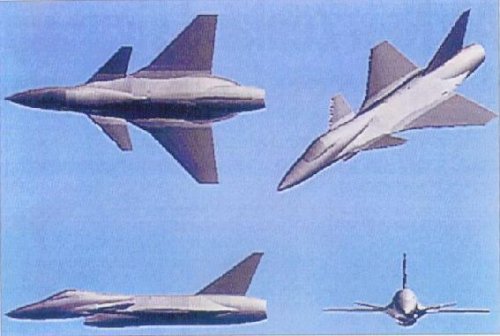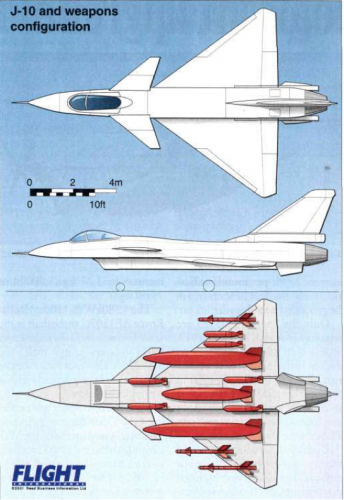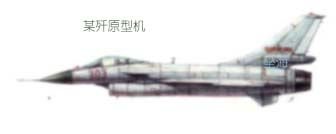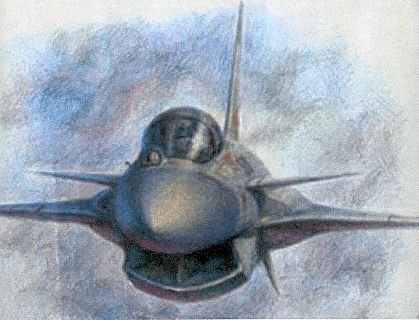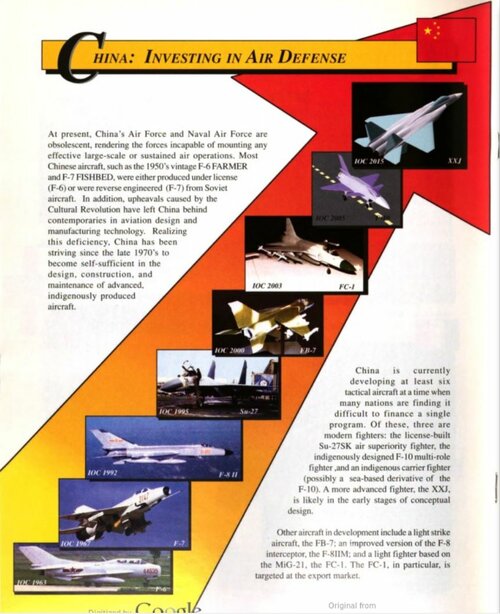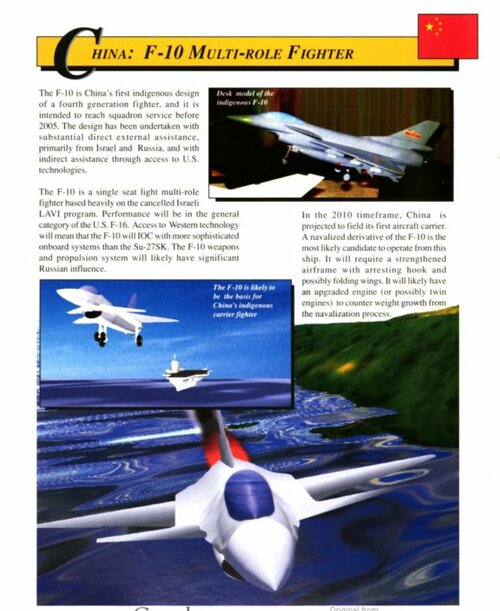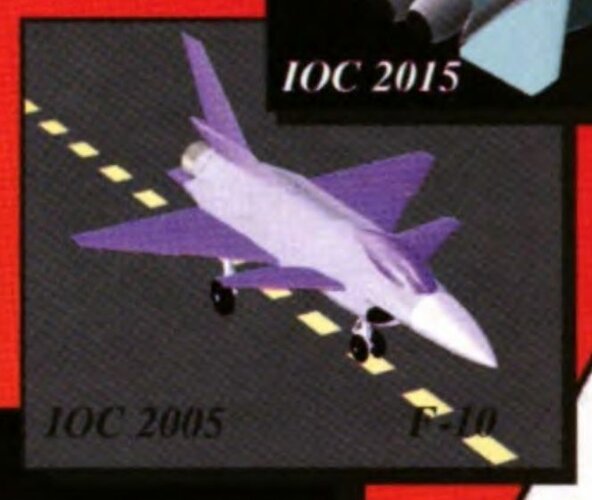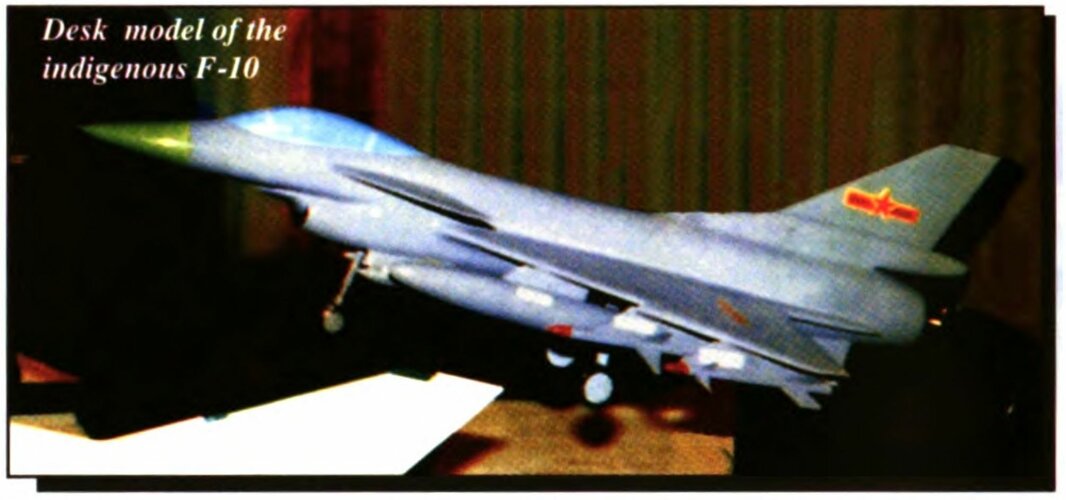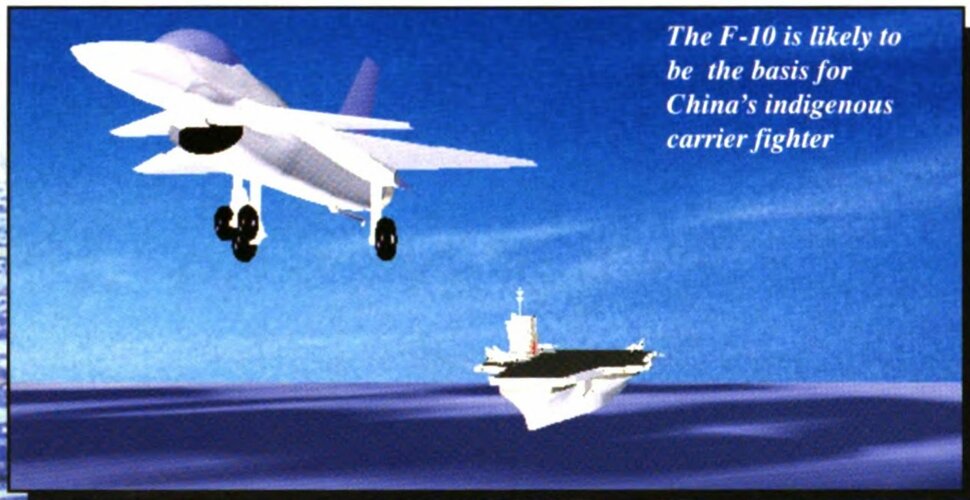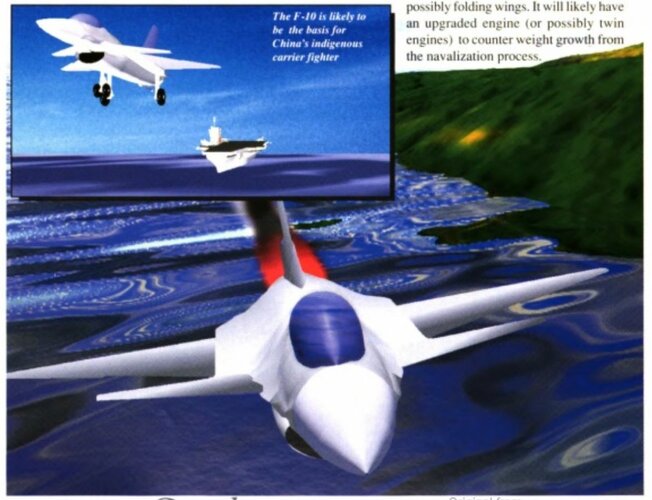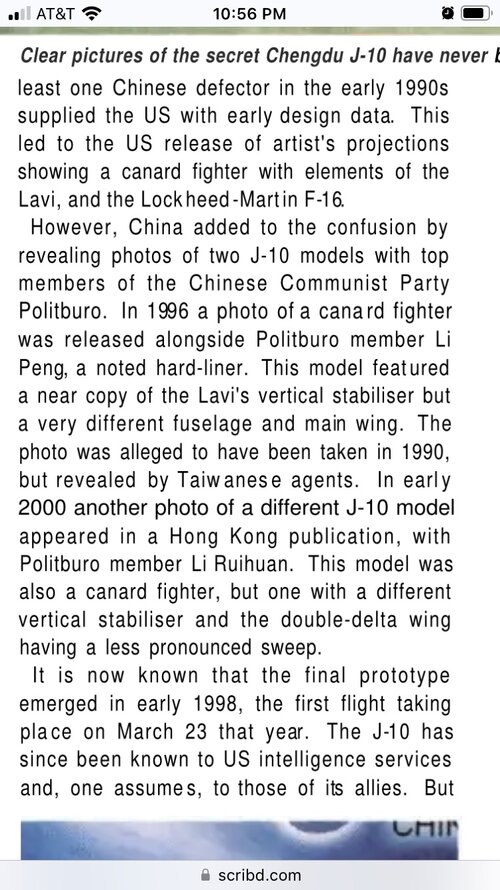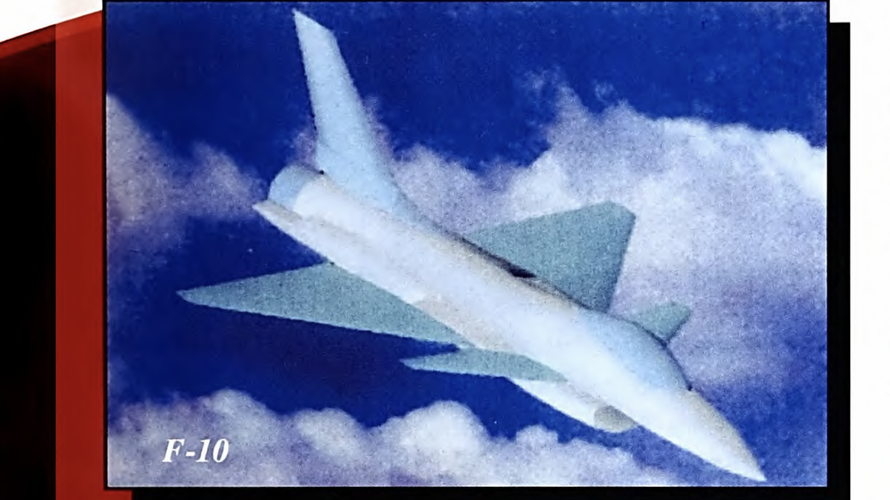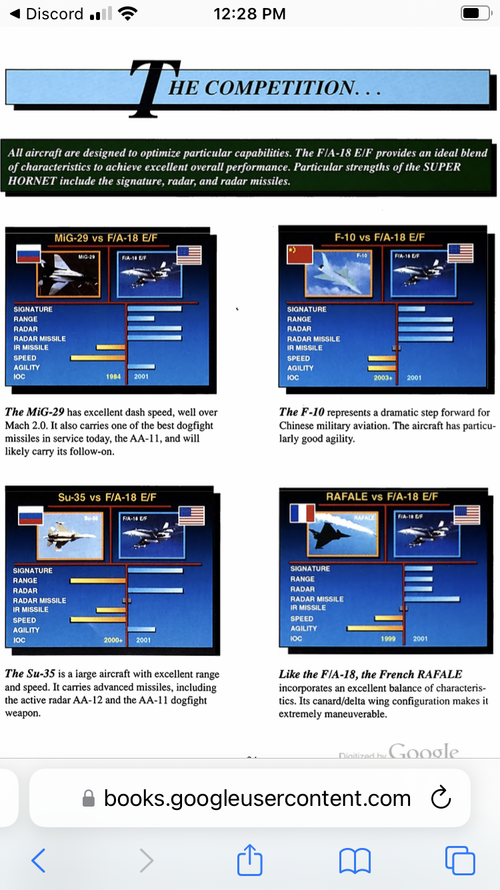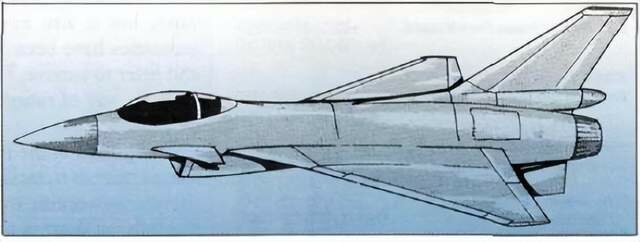NEW CHINESE FIGHTER NEARS PROTOTYPING
defense officials are circulating drawings within the Pentagon of the proposed next—generation F-10 Chinese fighter that show a relatively compact multirole aircraft resembling a cross between the U.S.-built F-16 and Israeli-built Lavi. The design calls for a single-engine fighter with a planform similar to the Lavi's delta wing and canard. It also incorporates advanced cockpit avionics including a headup display, radar for beyond-visual-range combat and provisions for radar-guided, air-to-air missiles. A US. official called the equipment package ”analogous to the F-16's” and appropriate for both interceptor
and ground attack missions. The F-10 program is said to be nearing prototype production, with First flight expected in the next year or two and initial
operating capability in 10 years. It represents one of China’s key Iong«term modernization efforts. Modernization of the Chinese air force and navy is expected to be fueled in part by a 21 % increase in I995 Chinese defense spending proposed two weeks ago. The official I994 Chinese defense budget was $6 billion, but analysts believe this year’s spending increase may have been offset by a double-digit inflation rate.
However, China analyst Thomas McNaugher, a Rand senior political scientist, said the actual defense spending is probably $20- 30 billion if the purchase of new military equipment and the income from military-run enterprises is included. The Chinese budget has seen double~digit raises since I990, he said.
Today, the Chinese air force and navy are "a line-of—sight fighting force, which in modern combat means it’s a dead force," a second pressing need for a beyond-visuaI-range multirole fighter drives modernization of China’s air force and draws Israeli technology support defense official said. As a result, the Chinese government is putting renewed emphasis into advanced technology for its air force and navy. Development of the F-10 complements the purchase of Russian-built Su-27 fighters as central elements of the country's aviation modernization.
”THERE [ALSO] IS CLEAR need for an airrefueling capability” on the fighter; although, it is unclear whether that will be part of the final design, the second official said. Fighter aircraft with greater range are a key Chinese mission need, considering the nation's commitment to preserving its sovereignty in the Spratly Islands in the South China Sea (claimed by Malaysia, Taiwan, Vietnam, Brunei and the Philippines) and the ParaceI Islands also in the South China Sea (claimed by the Vietnamese), he said. In February, China occupied Mischief Reef (claimed by the Philippines) about I30 mi. west of the Philippines.
Additionally, the Chinese surface navy has a very limited ability to defend itself from air attack, so "they need 0 CAP [combat air patrol] capability” that would demand long-range aircraft and in-flight refueling, the second official said. However, the Chinese have made little progress in developing an in-air-refueling or airborne early warning capability beyond identifying mission needs, he said. Israeli and U.S. defense officials confirmed that Israel Aircraft Industries (IAI) is offering help with the Chinese fighter's avionics package. Israeli officials deny any classified information or technology has migrated to China as a result of the collaboration. Israeli officials insist they are in full compliance with U.S. technology transfer law. The US. supplied Israel with technological support for the canceled Lavi. A U.S. official said the Pentagon is ”not in a position to say if the technology transfer is legitimate or not.”
The radar and other avionics that the Israelis are offering also are thought to be part of IAI’s Northrop F-5 Plus upgrade, which the company has offered to several countries including Chile (AW&ST Mar. 25, I99I, p. 46).
”If the only thing Israel [contributed] to the F-10 is a radar package and avionics, they are correct in saying they are violating no laws,” Richard A. Bitzinger said. He is a defense industry analyst for the Defense Budget Proiect, an independent, Washington-based research organization. ”But, if the Israelis also offered design assistance or manufacturing technologies to the Chinese that were based on the Lavi proiect, then there may have been a violation of at least the spirit of U.S. export controls.”
The F-5 Plus avionics upgrade is a scaled-down Lavi package, with options
* Video camera and recorder.
* Two multifunction displays.
* Helmet-mounted sight.
* Integrated electronic warfare suite.
Israeli officials point out that the U.S. has been the biggest customer for the country’s defense business for the last three years and, as a result, they would not do anything to irritate the Us. and endanger that lucrative market. However, within the U.S. restrictions, Israel, among other countries, has the capacity to supply many of China’s technology needs including updated avionics, early warning capability and in-flight refueling.
PART OF THE PENTAGON’S seeming indifference to Israel's marketing to China is that it sees little danger to the U.S. from the F-10. However, the aircraft could be a worrisome opponent to the air forces of Vietnam, the Philippines or even Malaysia’s small MiG-29 force.
”I’ve seen [the data on the ChineseF-10]," a senior Air Force official said. ”I was not a lot concerned.”
China appears to be pursuing the same strategy as India with its light combat aircraft (LCA). Indian officials are not trying to build an aircraft that outperforms the F-I6 or MiG-29. Rather, they want to field in some numbers an aircraft with improved performance to replace their aging MiG-21s (AW&STJuly 25, I994, p. 42). In fact, Chinese officials have expressed interest in participating in the LCA proiect during a recent visit to India. A planning dele gation from Hindustani Aeronautics, Ltd., visited China last month. The first prototype LCA is now expected to roll out in October, a slip of five months.
The Chinese are looking to the Russians for an engine to power their F-10s. The Israelis used the U.S.-built Pratt & Whitney I I20 turbojet to equip their Lavi, but there Lockheed Ft. Worth’s FM is said to be the apparent model for the F-10’s nose-to-tail profile. is almost no chance the Chinese could buy engines or engine-building technology from the US. Instead, the Chinese are expected to build off the technology, logistics and maintenance base they are developing in fielding a proposed force of 60 Russian-built Su-27s. The fighter’s 27,557—lb.-thrust with afterburning Saturn/Lyulka AL-3IF turbofan
engines are more durable (approximately 1,500 hr. versus 500 hr. or less) than MiG-29 engines, and are considered a likely candidate for the F-10. The Chinese currently have 24 of the front-line Su—27 fighters and have at least another ”26 or so" on order, the first defense official said, ”and we think they will ask for more” before the ”Russian window” closes.
Some analysts believe a combination of growing U.S. pressure to stop arms technology transfers, a disappearing supply of completed new combat aircraft and redirection of the aviation industry will dampen Russian weapons sales within a few years, thus closing the so-called Russian window.
THE FIRST CHINESE SU'27 Unit is not fully operational, but it has progressed to ”about where you would expect” any new user of the aircraft to be, the first official said. The unit is expected to be fully operational within the next 12 months. China’s purchases of Su-27s and Kilo class diesel submarines are considered aberrations in China's continuing policy of industrial self-reliance. The Chinese intend to learn from operating a fourth-generation
fighter what it takes to maintain, operate and generally ”deal with” modern aircraft, the first official said.
An earlier attempt to add Western technology to an indigenous airframe—the Shenyang Aircraft Corp. F-8-2 Finback B fighter/ground attack proiect foundered after US avionics deals were canceled in the wake of the I989 Tiananmen Square massacre. The program was canceled in 1990.
But then in I991, the allies’ quick dismemberment of the huge Iraqi army (fourth largest in the world) in Desert Storm ”had a devastating impact on Chinese force planners," the second defense official said. The graphic example of what an integrated force can do during high-intensity operations to a force incapable of combined operations came as a ”deep psychological shock.”
BUILDING FROM THE BASE of knowledge established with the Su-27, the Chinese intend a longer-term technology leap with the F-10. The new indigenous fighter is intended to be available in ”2000 or soon after," the first official said. ”What we don’t know is whether the PTO will appear with [less sophisticated] F-16A technology or [advanced] F-16C technology," the first defense official said. ”And we won't know until the proiect gets further along. The technology is hard to see at this point. We need more insight into their interests and the availability of technology.”
If the F-10 program is successful, U.S. officials expect the Chinese to build ”a couple of hundred or more,” the first defense official said. There is yet no indication that the Chinese are pursuing a naval version of either the Su-27 or F-IO. Purchase of the surplus Ukrainian-built aircraft carrier Varyag was tempting to the Chinese and money could have been found, US. defense officials said. But top Chinese defense officials considered the political cost of being seen as a potential regional aggressor as too high for the present.

